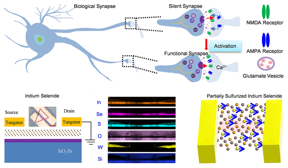Home > Press > SUTD researchers develop ultra-scalable artificial synapse
 |
| Brain-inspired device used for integrating both silent and functional synapses
CREDIT SUTD |
Abstract:
A research team, led by Assistant Professor Desmond Loke from the Singapore University of Technology and Design (SUTD), has developed a new type of artificial synapse based on two-dimensional (2D) materials for highly scalable brain-inspired computing.
SUTD researchers develop ultra-scalable artificial synapse
Singapore | Posted on December 24th, 2021
Brain-inspired computing, which mimics how the human brain functions, has drawn significant scientific attention because of its uses in artificial intelligence functions and low energy consumption. For brain-inspired computing to work, synapses remembering the connections between two neurons are necessary, like human brains. In developing brains, synapses can be grouped into functional synapses and silent synapses. For functional synapses, the synapses are active, while for silent synapses, the synapses are inactive under normal conditions. And, when silent synapses are activated, they can help to optimize the connections between neurons. However, as artificial synapses built on digital circuits typically occupy large spaces, there are usually limitations in terms of hardware efficiency and costs. As the human brain contains about a hundred trillion synapses, it is necessary to improve the hardware cost in order to apply it to smart portable devices and internet-of things (IoTs).
To tackle this issue, the SUTD research team mimicked behaviors of functional and silent synapses using 2D materials. Additionally, this artificial synapse demonstrates for the first time that it can be implemented with the same device that functions as both functional and silent synapses.
Assistant Prof Loke mentioned that this work can dramatically reduce the hardware costs by replacing functional and silent synapses that were based on complex digital circuits with a single device. We have demonstrated that functional and silent synapses can be implemented using a single device.
By integrating functional and silent synapses into the same device using ultrathin 2D materials, the hardware cost of artificial synapses will significantly decrease, which will drive the commercialization of brain-inspired hardware. added Assistant Prof Loke.
From the viewpoint of neurobiology, silent synapses would not generate excitatory behavior when presynaptic neurons receive continuous stimuli because they contain N-methyl-D-aspartate (NMDA) receptors, but they lack the alpha-amino-3-hydroxy-5-methyl-4-isoxazole-propionic-acid (AMPA) receptors. However, silent synapses can be activated to become functional synapses that respond to stimulations upon the insertion of AMPA receptors after consecutive stimulations. Inspired by the biological mechanism for silent synapse activation through the insertion of AMPA receptors, transformations from silent synapses to functional synapses in devices can be achieved by introducing sulphur anions in 2D indium selenide material systems. The sulphur anions in indium selenide can migrate under an electric field and exhibit functional synaptic plasticity. This device, based on a fully sulfurized type of system, show obvious memristive behavior at room temperature, which can be used to implement functional synapses. The activation of silent synapses can be demonstrated using a partially sulfurized type of system by modifying the temperature.
This research was published in ACS Applied Materials & Interfaces. The research team include Song Hao, Khin Yin Pang, Nan Wang, Huimin Li, Yu Jiang, Kian-Guan Lim and Tow-Chong Chong from SUTD, and Shuai Zhong, Xinglong Ji and Rong Zhao from Tsinghua University.
####
For more information, please click here
Contacts:
Melissa Koh
Singapore University of Technology and Design
Office: 65-649-98742
Copyright © Singapore University of Technology and Design (SUTD)
If you have a comment, please Contact us.
Issuers of news releases, not 7th Wave, Inc. or Nanotechnology Now, are solely responsible for the accuracy of the content.
2 Dimensional Materials
![]()
Researchers uncover the mechanism of electric field detection in microscale graphene sensors December 24th, 2021
![]()
Two-dimensional bipolar magnetic semiconductors with high Curie-temperature and electrically controllable spin polarization realized in exfoliated Cr(pyrazine)2 monolayers December 3rd, 2021
![]()
Developing high-performance MXene electrodes for next-generation powerful battery November 19th, 2021
![]()
A new dimension in magnetism and superconductivity launched November 5th, 2021
Discoveries
![]()
Researchers uncover the mechanism of electric field detection in microscale graphene sensors December 24th, 2021
![]()
Major instrumentation initiative for research into quantum technologies: Paderborn University receives funding from German Research Foundation December 24th, 2021
![]()
Examining recent developments in quantum chromodynamics: A new collection looks at recent development in the field of quantum chromodynamics from a range of perspectives December 24th, 2021
![]()
Using magnets to toggle nanolasers leads to better photonics: Controlling nanolasers with magnets lays the groundwork for more robust optical signalling December 24th, 2021
Announcements
![]()
Researchers uncover the mechanism of electric field detection in microscale graphene sensors December 24th, 2021
![]()
Major instrumentation initiative for research into quantum technologies: Paderborn University receives funding from German Research Foundation December 24th, 2021
![]()
Examining recent developments in quantum chromodynamics: A new collection looks at recent development in the field of quantum chromodynamics from a range of perspectives December 24th, 2021
![]()
Using magnets to toggle nanolasers leads to better photonics: Controlling nanolasers with magnets lays the groundwork for more robust optical signalling December 24th, 2021
Artificial Intelligence
![]()
DeepMind simulates matter on the nanoscale with AI December 10th, 2021
![]()
Quantum Physics in Proteins: Artificial intelligence affords unprecedented insights into how biomolecules work November 5th, 2021










